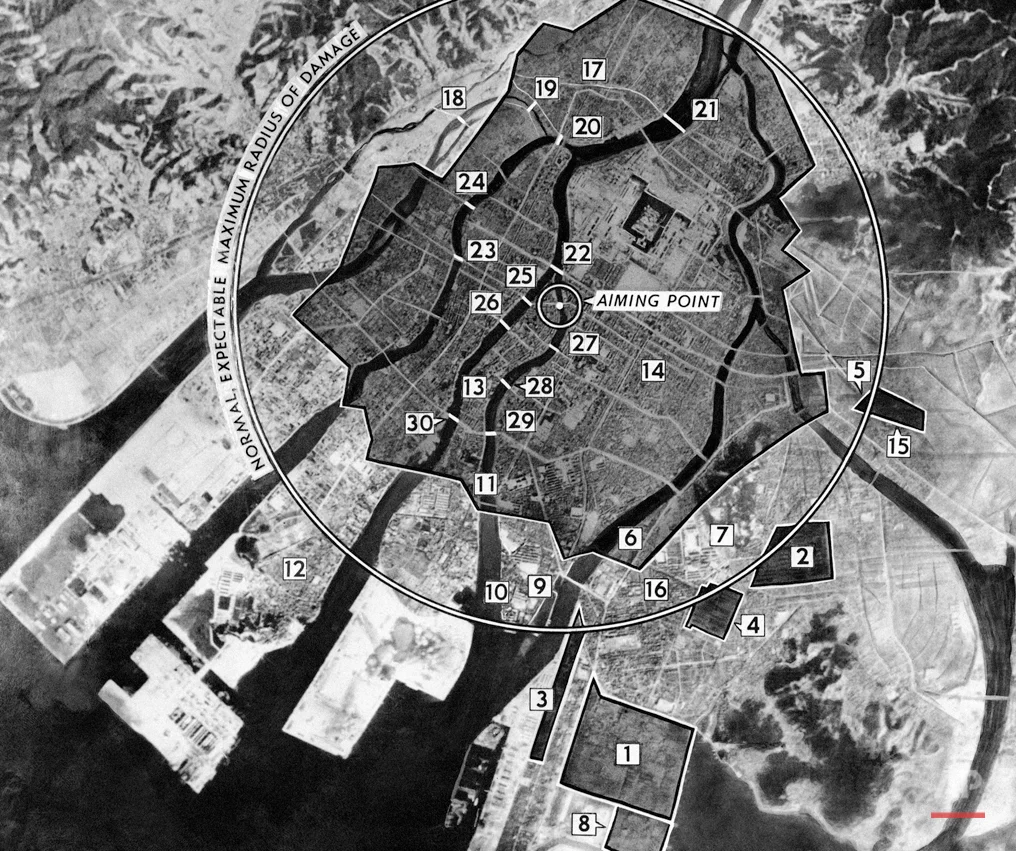Here is a map that shows the large military district in the center of the city
First, the map is from 1944, so it does not represent the situation in 1945 since many units moved out as the war progressed and things dispersed after Japanese cities became target of strategic attacks
Second, even if we accept that the situation remained unchanged, the point is that the US air force did not bother to bomb this installation and Hiroshima was not in the priority list. So, they saw in 1944 (as your map shows) these installations and decided that Hiroshima was not really an important target. So, claiming that suddenly such army installations justified the killing of dozens of thousands of civilians does not cut it.
Third, as I said, I know that there was a HQ at the time of the bombing and that no HQ has 20,000 people. And finally, the most credible evident we have do not talk about 20,000 casualties. And since you put the effort to show a map (even dated) I appreciate the effort, so I will post the map from the strategic survey which shows the HQ in the middle of the city but in a different post to keep this one relatively short
There was a large military district surrounding the headquarters. Many of the dead soldiers were fresh recruits waiting to be deployed to the beaches to resist our invasion.
Nope!
First the HQ at the time of your map did NOT exist! It was organized in mid April 1945 and was detected by signal intelligence units by the end of the moth. So, it is impossible to claim that the her was surrounded by the military district. I will provide evidence of what I say in subsequent post
I can’t think of a target that would do greater damage to the Japanese military
That HQ was not even in charge of the tactical situation in the island that was the object of the invasion. And destroying such hq months before the invasion is like arguing that leveling off Paris in February of 1944 would have given a military advantage for the June, 6th, 1944 invasion. It would not! Rommel and the armies which were tactically responsible for the German defense in Normandy did not direct the battle from Paris. They reported to their HQ in Paris (OB West).
The estimate of 43,000 soldiers is mentioned on page 713 of “The Making of the Atomic Bomb” by Richard Rhodes.
“Downfall” by Richard B Frank also mentions it, with this cite: “SRH-203, 11/12 Aug, No. 120.”
SRH-203 is mentioned here:
I’m not sure how to access SRH-203 itself however.
I will have a look because I think I have Downfall.
The estimate of 20,000 dead soldiers seems to have originated from Japanese peace sites about 15 years ago:
I am not sure where they got it from however, as they don’t offer much in the way of cites.
This sounds dubious and less trustworthy from the number of the 6,000 dead soldiers which appears in the strategic bomb survey that took place during the occupation
The beaches where we would have come ashore in southern Kyushu and the Tokyo plain were limited in area too.
Japan had 10,000 kamikazes waiting to pounce on our troop transport ships when we invaded southern Kyushu.
The beaches in Sicily and the ground in Italy was very restrictive too. This did not result in massive casualties among the allies. Again, in the case of a Japanese invasion, the allies would be free to outmaneuver Japan defense lines from the sea (as they tried to do with Anzio in Italy) and unlike the Germans, the Japanese did not have the panzer division to react fast to such threats.
Japan had 10,000 kamikazes at least three months Meroe the start of the invasion. The Germans could not flu but a handful of airplanes on d day because they were forced to abandon the airfields near Normandy under relentless TACTICAL targeting against their air force.
In subsequent posts I will present specific pages from my digital collection. If I miss to clarify something, notify me.







